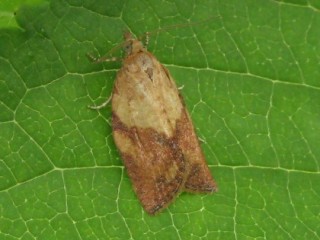
Light brown apple moth (a tortricid) is a minor, but sporadic pest of apple in the UK. The life cycle involves at least two generations per annum in the UK. The moth has a very wide host range and the larvae are known to feed on over 120 plant species.
It is generally controlled by sprays targeted against codling moth and other tortricid pests and in UK horticulture it more often causes damage to cherry and plum because of the limited choice of insecticides available for and used on these crops.
Larvae are leaf-rollers and damage is similar to other leaf-roller species. Damage to foliage is unimportant. Fruit generally suffers from surface damage but young larva may enter fruit through the calyx.
The identification of larvae is difficult as they are very similar to the larvae of other leaf rollers. The pest should be monitored with pheromone traps weekly from petal fall of apple to the end of August. The economic threshold for treatment is >30 moths per trap per week.
